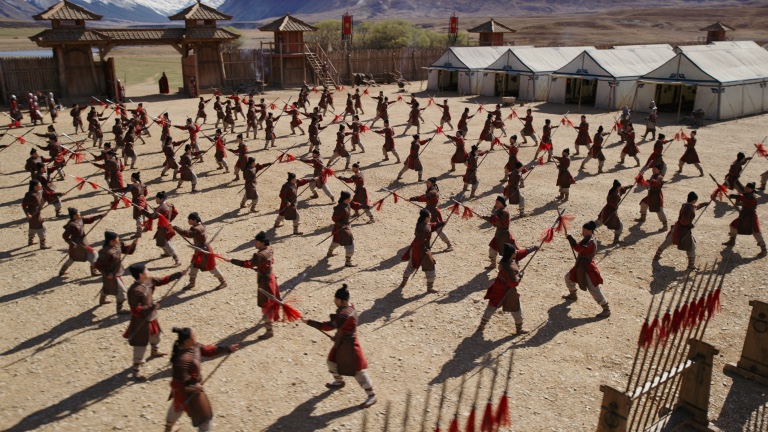
Indeed, it’s been over a decade since Friedberg last designed for TV, having worked on such films as Kate and Leopold, The Life Aquatic with Steve Zissou, The Producers, Across the Universe and The Tempest for Julie Taymor.
But Friedberg was attracted to the project – a more faithful adaptation of the Depression-era James M. Cain novel, made famous in its earlier film noir version starring Joan Crawford – by a chance to work with director Todd Haynes again. The two had notably paired on the earlier feature Far From Heaven, starring Julianne Moore in a 50s-set tale of various forbidden loves, given a glossy hyper-real lushness designed to emulate the films of director Douglas Sirk.
This project, Friedberg says “couldn’t get made as a feature,” and he notes that “TV is picking up the slack” of difficult projects that studios often won’t greenlight as films, the way they might have in the 70s. But this fit with the initial concept Haynes discussed with him – an idea of the series looking like a 70s film version of the 30s: realistic and unvarnished, in the manner of such films as Bound for Glory and Chinatown.

As for the latter film, its production designer, the late Richard Sylbert, plucked several locations around an already-changing Los Angeles to approximate, or recreate, its Depression-era look, though he once commented in a Below the Line symposium that even then it was a challenge finding enough “old L.A.” to shoot in.
For Mildred Pierce, after several additional decades of relentless L.A. redevelopment, the answer was to shoot 3,000 miles away. The tale of a strong-willed, yet ultimately flawed “grass widow” – a divorcee before such things were practically de rigueur – the story is set initially in Glendale, and its environs.
Friedberg acknowledges much help from the Glendale Historical Society, since the “historical veracity was important,” and indeed, part of the “social commentary on Todd’s part. The idea is this is a transitional time. Power will shift to people who do the work.”
But given the copious research, Friedberg says that while they originally expected to shoot in L.A., “ironically, we were able to find those things here in New York,” where the interiors were filmed on stages. Key locales, like Pierce’s Glendale bungalows were found upstate, as well as the “Hollywood diner” they used.
 The bungalows were a surviving batch of Spanish-style courtyard apartments, which they re-stuccoed. “We were going to have to build either way,” Friedberg says of recreating the era, and yet they found more of the era surviving back East.
The bungalows were a surviving batch of Spanish-style courtyard apartments, which they re-stuccoed. “We were going to have to build either way,” Friedberg says of recreating the era, and yet they found more of the era surviving back East.
They wound up CG’ing the Hollywood Hills and San Gabriels into various shots. One wide shot early on, showing traffic moving down a Glendale street is utterly sun-dappled and convincing, (even if you’re left scanning for familiar landmarks while Winslet walks around Hollywood).
Friedberg observes that this is a reversal of a CG process they would have had to use even if they had filmed in Los Angeles, where recurring fits of “real estate exuberance” had changed the landscape. Thus, while some of the 30s might survive, “all the stuff built in-between, would have to be removed in CG.”
In other words, you might have the San Gabriels in the actual shot, but you’d be notching out the shopping malls and freeways in post.
As for interiors, Haynes’ idea was “to shoot through things – using a lot of glass as a filter,” and have it refracting the various aspect of Pierce’s character. “She’s fierce and determined – in a domestic setting. She’s a brilliant literary character.”

But as refracted as she might be, as a mother, a businesswoman, a lover and a tragic figure, her domestic landscape actually wouldn’t be that cluttered. The era, he notes, also lent itself to “negative space,” an emptiness – or perhaps stillness – that came from a lack of money, or credit, and the fact that jamming googaws into one’s living space “wasn’t about any social movement,” once upon a time.
There might be “a plant or two maybe,” he says, perhaps one or two things on the walls, but much would be empty. “Cain describes a part of the house for show and another part for living,” and each would be designed accordingly. In fact, Friedberg notes that “a lot of the set decoration descriptions are part of the novel. It’s intriguing. It’s actually in the dialogue.”
And there were certainly a lot of chunks of dialogue to keep everyone on their toes – usually up to “four to five pages a day.” Yet, Friedberg reports that this project wasn’t all that different from designing features, rather it was “like doing three movies, back to back.” He describes the schedule as “grueling, but exciting. It was the best kind of grueling.”
They made, Friedberg says, “a six-hour film for under 30 million.” He says he is quite happy with the “level of detail and scope” they were able to bring to the project. “It all ends up in the movie,” he recounts.
A kind of thriftiness that Mildred Pierce herself might appreciate. At least, before her downfall.





